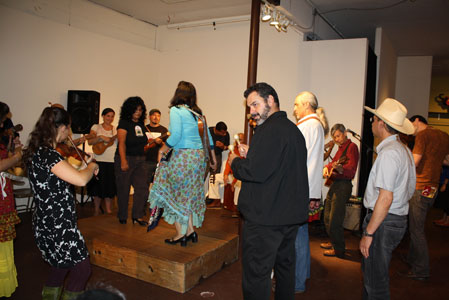This website uses cookies so that we can provide you with the best user experience possible. Cookie information is stored in your browser and performs functions such as recognising you when you return to our website and helping our team to understand which sections of the website you find most interesting and useful.
By Lily Kharrazi, ACTA’s Living Cultures Grants Program Manager
 Galeria de la Raza in San Francisco produced a free event, El Son Jarocho en California: Taller-Encuentro-Fandango, based on the music, dance, and poetry originating from the southern region of Veracruz, Mexico. Funded by ACTA’s Living Cultures Grants Program, this rich cultural expression was in full bloom during the day and into the late evening hours as a multi-generational crowd participated in workshops and a presentation that explored the three essential elements of the son jarocho – music and playing technique, poetry, and dance. Both beginners and veteran musicians were welcomed. The evening concluded with a participatory party, or fandango.
Galeria de la Raza in San Francisco produced a free event, El Son Jarocho en California: Taller-Encuentro-Fandango, based on the music, dance, and poetry originating from the southern region of Veracruz, Mexico. Funded by ACTA’s Living Cultures Grants Program, this rich cultural expression was in full bloom during the day and into the late evening hours as a multi-generational crowd participated in workshops and a presentation that explored the three essential elements of the son jarocho – music and playing technique, poetry, and dance. Both beginners and veteran musicians were welcomed. The evening concluded with a participatory party, or fandango.
This event is one of several son jarocho events that are occurring in California and are part of growing phenomenon. The son jarocho is not only a distinct genre transported from its original home, but has come to represent a nexus of creativity involving an international and transborder dialogue between Mexico and American born Chicanos. The form is supple enough to incorporate multiple experiences of Mexican and Mexican-American identity and this is being translated into the music and practice of the son jaracho.
The son jarocho allows for an ensemble both large and small to play together on various string instruments. They include the guitarra de son which plays melody to the small guitar-like instrument, affectionately known as “mosquito,” which provides rhythm. Other guitar-type instruments, or jaranas, also add to the textures of rhythm as do the bass-like leonas, tambourines, and donkey-jaw providing percussion. These traditional instruments were in abundance as well as a few electric guitars and electric bass which were included in the presentation of one ensemble, Los Soneros del Este. Indicative of the way in which the tradition can accommodate innovation, the influences of Carlos Santana’s clear melodic rifts as well as the music of Los Lobos, hailing from East Los Angeles, have all played a role in the musical influences of Mexican Americans and can find their way into the son jarocho.

